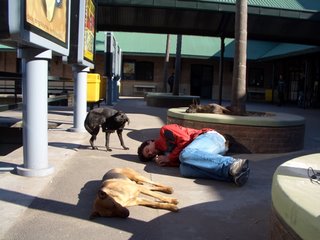What a Wonderful World It Would Be

On Saturday I made my way to the Museo Histórico Cornelio Saavedra. The museum occupies Saavedra’s former house and is located in a public park that was once his chacrita – his “little farm” – of 250 acres. This is like calling a spa in Montana a “dude ranch”; the chacrita was a landscaped garden filled with statues and exotic trees.
The property backs onto the Avenida General Paz, which is in fact an expressway that rings the city. It
 seems like yet another forced attempt to make Buenos Aires imitate Paris. The Boulevard Périphérique isolates Paris from its banlieue; the Avenida General Paz severs la Capital from its outlying suburbs, known collectively as Gran Buenos Aires.
seems like yet another forced attempt to make Buenos Aires imitate Paris. The Boulevard Périphérique isolates Paris from its banlieue; the Avenida General Paz severs la Capital from its outlying suburbs, known collectively as Gran Buenos Aires.The museum houses a collection of nineteenth century historical artifacts and knickknacks, including ornate, faux-gaucho saddles, weapons, tattered flags, and the enormous, tortoise shell peinetones (see pictures), which must have made elegant porteñas stumble when attempting the newest dances from Europe.
These were pointed out by our guide Jorge, an excitable man in his fifties who exhibited childish delight stepping over velvet cordons to lay his hands on off-limits artifacts. He particularly relished showing us the chair used by the ailing General San Martín while exiled in France. The chair was essentially a nineteenth century laz-e-boy. Jorge showed us at least four times how the seat reclined with the push of a button.
The most memorable portion of the visit, however, took place when we moved into the room dedicated to the Argentine Federation, the turbulent era of the dictator Juan Manuel de Rosas (1829-1852). In simple terms, Rosas was the leader of the Federalists, who believed in the rights of individual provinces. Their rivals were known as the Unitarians, who were enamored with European republican ideals and advocated the establishment of a centralist government with Buenos Aires as its capital.
Jorge stood beneath a blood red flag of the Federation that read ¡Muerte a los asquerosos inmundos salvajes unitarios! (Death to the disgusting vile savage Unitarians!) Incidentally, Rosas and his followers typically signed all official correspondence with such slogans.
For the next forty-five minutes, our group listed to Jorge deliver a diatribe that was impressive for both its internal contradictions and its earnestness. Essentially, Rosas was the defender of authentic Argentine culture, while the Unitarians were a bunch of traitors who were too busy brownnosing French and English industrialists and merchants to understand their native land. Substitute “Perón” for “Rosas” and “the oligarchy” for “the Unitarians,” and Jorge might as well have been talkin’ 20th century history blues.
What was most astounding is that I was listening to this impassioned rant in a public museum administered by the government of the city de Buenos Aires. Imagine going to Mount Vernon and listening to a docent explain to you that Jefferson Davis was the greatest American patriot that ever lived because he didn’t buckle to the newfangled industry of the North, which was tearing apart the fabric of true American society.
Come to think of it, things like this happen probably far more than I care to admit.
In any case, Jorge concluded the tour by exhorting “we Argentines” to understand “our” history better. Having bit my tongue throughout the tour, I informed Jorge that I was North American.
You don’t say! he shouted and gave me a big, sweaty hug.



0 Comments:
Post a Comment
<< Home